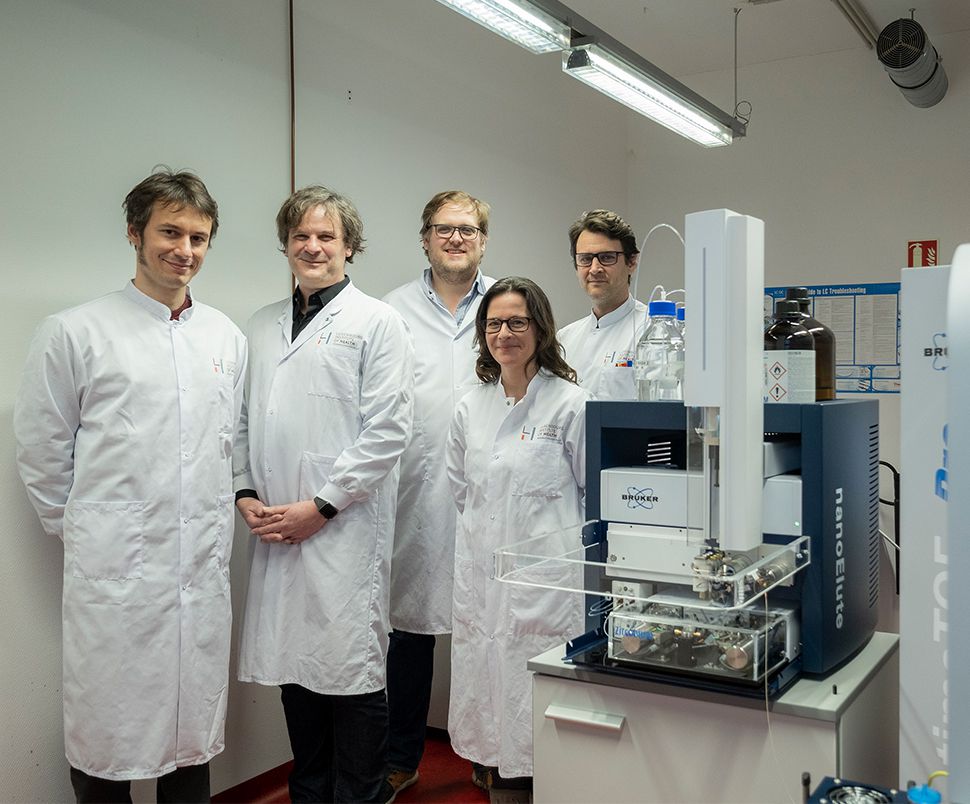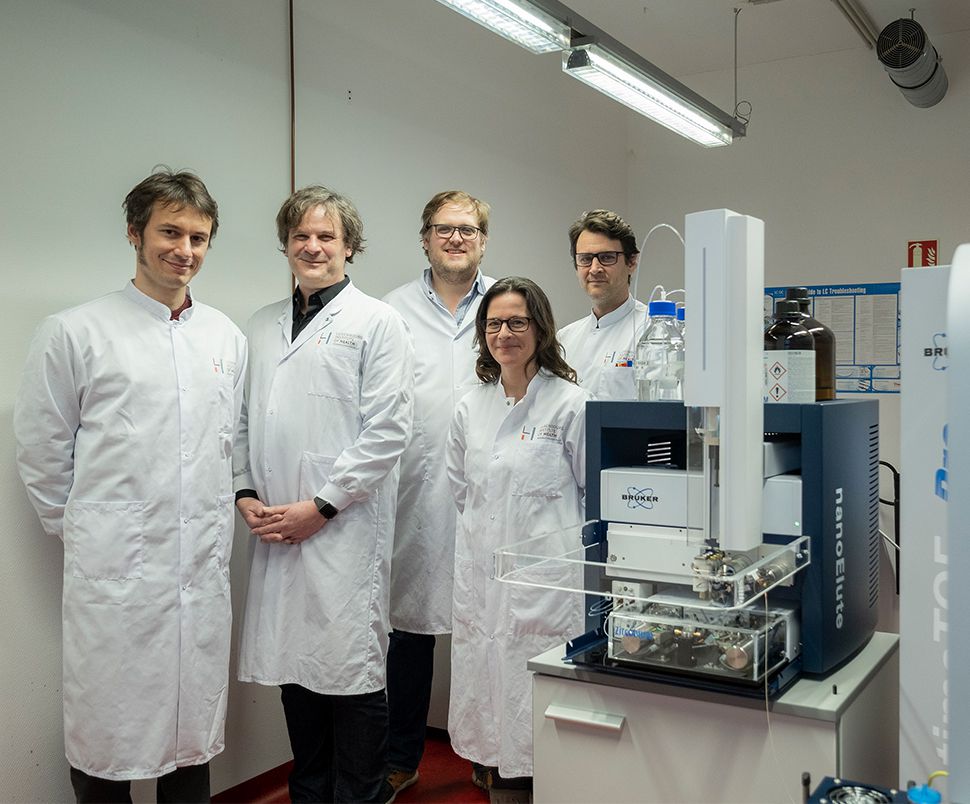News
Targeted proteomics for personalised medicine at LIH

Prof Gunnar Dittmar celebrates his 100th publication
The field of proteomics, i.e. the characterisation of the complete pool of proteins produced by a cell, is acquiring increasing importance in understanding the onset of various diseases and devising new personalised treatments. At LIH, this area is being explored by Prof Gunnar Dittmar and his team at the Proteomics of Cellular Signaling research group of the Quantitative Biology Unit (QBU). His work has resulted in the publication of his 100th scientific paper in the January 2021 issue of the prestigious international journal “Analytical Chemistry”. In this interview, Prof Dittmar discusses his expertise and research focus.
Prof Dittmar, can you tell us more about your academic background and expertise?
G.D.: I am originally a chemist with a specialisation in biochemistry obtained through my studies at Darmstadt Technical University. I then steered towards cancer research, and specifically cancer cell and molecular biology, during my time as a PhD candidate and subsequently post-doctoral fellow in Heidelberg. I left Europe in 1997 to spend six years in Boston, at the Harvard Medical School, first as a post-doctoral fellow then as a member of the teaching faculty, using genetic systems to probe the ubiquitin-proteasome system. That is when I started delving into the then-emerging field of proteomics, looking particularly at aspects such as protein degradation and the ubiquitin-proteome. I subsequently returned to Germany to continue this line of work at the Max-Delbrück Center for Molecular Medicine in Berlin, where I became group leader of the post-translational signalling group. It was during that period that I set up the first proteomics facility at the Max-Delbrück Center which, by the end of my time there, boasted 12 mass spectrometers, making it one the largest proteomics centres in Germany. In parallel, in 2014, I also started and headed the proteomics facility at the Berlin Institute of Health. I finally joined LIH in 2016 to run the former proteome and genome research lab, and started building up the present QBU in 2018 as a technical unit combining platforms and research groups. I am now concomitantly Head of the Proteomics of Cellular Signalling Group, Head of the LIH side of the LuxGen next-generation sequencing centre (which is a joint effort with the Laboratoire National de Santé – LNS) and Deputy Head of QBU.
What is your specific research area here at QBU/LIH?
G.D.: My lab is particularly interested in understanding how protein interactions are influenced by post-translational modifications (PTMs), and how these modifications affect and regulate cell growth. PTMs are chemical changes which take place after the protein has been made, and constitute an invaluable source of information to fathom the mechanisms that lead to unrestricted cell growth and, consequently, to diseases such as cancer. We have a considerable expertise in this area and many ongoing collaborations with renowned international partners. Indeed, we recently developed a new technique called PrISMa (protein interaction screen on a peptide matrix), which allows us to map many protein-protein interactions at the same time and determine how PTMs influence these interactions. This technique enabled us to analyse what we call the “interactome”, i.e. the complete set of protein interactions in a cell, and the PTM-induced changes occurring in two specific cancer-relevant transcription factors, C/EBPα and C/EBPß. C/EBPα is mutated in 10-15% of human acute myeloid leukemia (AML) patients. Certain PTMs are of particular importance in the regulation of the C/EBPα, where disregulation can lead to cancer. We are essentially leveraging our advanced and cutting-edge in-house technologies to generate a comprehensive view of these molecular events and to identify new regulatory pathways involved in the development of many types of cancers. A second related line of research is the signalling of the ubiquitin system, i.e. the modification of a protein through the addition of a small protein called ubiquitin. If the ubiquitination process goes wrong, the resulting messages sent by the ubiquitinated protein can be disrupted, potentially leading to cancer. We are trying to further understand these ubiquitin-mediated signalling processes and their role in disease onset. Finally, we are actively working with our international partners to develop novel applications for mass spectrometers for what we call targeted proteomics. This actually led to our 100th publication.
Can you tell us more about the 100th publication and the main findings?
G.D.: The paper, which involved Antoine Lesur, François Bernardin and myself, appeared in the January 2021 issue of the prestigious journal “Analytical Chemistry”, and is one of the 19 articles my lab published and contributed to in 2020. It was carried out in collaboration with Bruker, a leading manufacturer of mass spectrometers worldwide, and describes a new methodology for targeted proteomics, i.e. the sensitive identification and measurement of a specific protein of interest in a biological sample. Essentially, we developed a method known as prm-PASEF (parallel reaction monitoring – parallel accumulation−serial fragmentation) which runs on Bruker’s new flagship mass spectrometer timsTOF Pro. Our application allows protein detection and quantification by ionising the peptides derived from the proteins to be analysed, holding them stationary in an ‘ion mobility trap’ and separating them based on differences in their shapes and mass, resulting in the rapid and highly sensitive characterisation of peptides when compared to other techniques. Indeed, after about a year of intense work with Bruker, we obtained a 10-fold increase in sensitivity and rapidity! To demonstrate the ability of our method to accurately quantify proteins of interest, we tested the application on lung and colon carcinoma cell samples to detect the expression of three different RAS proteins, namely KRas, HRas and NRas, as well as their most common mutations. These mutations are known to drive cancer development and affect patient response to immunotherapy, and are thus important diagnostic biomarkers. We were able to successfully identify all the expected mutations that characterised our original samples and detect greater amounts of the proteins compared to other techniques, which confirmed the excellent selectivity and sensitivity of our prm-PASEF method.
And what is the relevance of this new prm-PASEF application in terms of translational medicine and clinical practice?
G.D.: The features of our method make it particularly well suited for use in clinical and translational studies. Indeed, because of its ability to accurately measure and characterise up to 400 peptides in only ten minutes instead of hours, it will facilitate the characterisation of the mutational status of tumour cells, thereby improving the measurement of diagnostic biomarkers for cancer and other diseases. This will in turn allow the characterisation and stratification of large cohorts of patients, for instance as ‘responders’ and ‘non-responders’ to a given treatment, based on their precise protein profiles. Recently for instance, targeted proteomics applications have been used to distinguish benign from malignant lung nodules, as well as for the prediction of spontaneous preterm delivery in asymptomatic women. Furthermore, the high selectivity of prm-PASEF makes it a valid alternative to immunoassays, replacing antibodies in clinical diagnosis and routine testing and thereby avoiding some of the drawbacks associated with this technique.
And what about the collaborative aspect in the context of this 100th publication and of your research in general?
G.D.: In addition to the tight cooperation with Bruker, which gave us first-hand access to their advanced mass spectrometer here at LIH, the collaboration with Dr Elisabeth Letellier from the Life Sciences Department of the University of Luxembourg was equally very important from a clinical perspective. Indeed, she provided the patient-derived cell lines which allowed us to test our novel method and prove its accuracy. Looking forward, our group aims to further optimise and refine these novel targeted proteomics methods and apply them in the clinical setting, leveraging our established collaborations with industrial and academic partners such as Bruker and the University of Luxembourg. Namely, we aim to adapt prm-PASEF for use on complex biofluids like serum, in view of using it for the characterisation and stratification of cancer patient cohorts. Moreover, we want to combine this new methodology with other techniques we developed, so as to shed light into the role of post-translational modifications, and particularly ubiquitination, in regulating cell growth and triggering disease.
The paper “Highly Multiplexed Targeted Proteomics Acquisition on a TIMS-QTOF” (2021, 93, 3, 1383-1392) is accessible here.








